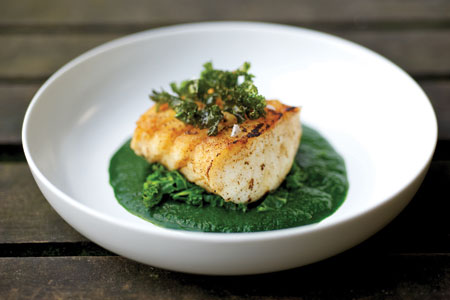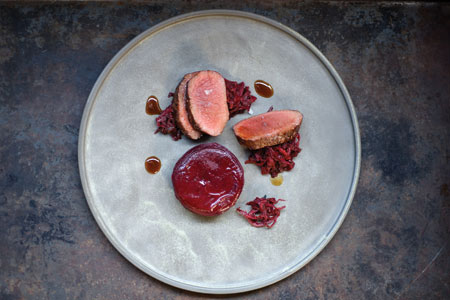What's in season: April/May
Next month sees a reduction in the price of early spring produce and a new wave of summer ingredients too, says fresh food produce supplier James Wellock. Meanwhile, the British Larder's Madalene Bonvini-Hamel cooks up some seasonal recipes
It's almost May, and what a special month to look forward to, ingredients-wise. The early spring produce, which was too expensive for some pockets, comes into reach for everyone as prices come down. And new summer produce will be winging its way into kitchens too.
The highlight is asparagus and, fingers crossed, the weather will be kind to us and give us nice warm nights as well as days to heat the soil and get the bulbs cracking.
The renaissance in UK asparagus has gathered pace over the past few years, allowing growers to invest in the crop. Asparagus takes three years to reach full yield, so expansion takes time, but unlike other roots, such as rhubarb, which is finished after one crop, the asparagus root will give 10 years of growth. Each part of the country now has specialised asparagus growers, each with their own twist: organic, hand-graded and tissue cleaned, ice-bathed, specially packed, electronically graded or grown in polytunnels.
Fresh green almonds have the shortest of seasons, but May is their month and they are a must. The fuzzy green hull and the soft nut inside are such a delicacy. The watery, tangy flavour of the nut tastes like a cross between a grape and a Granny Smith. My favourite way to eat them is washed and then tossed in olive oil and sprinkled with salt - a great bar snack that your customers will not have seen before. There are also many ways to use the inner, but however you serve it, the key thing is that they must be fresh.
May is mushroom heaven, with St George available at the beginning of May alongside beautiful cep, morel, girolle and mousseron.
There will be an abundance of soft fruits, with white, yellow and flat peaches, nectarines and apricots flooding in from Europe. The choices will be endless with prices to match, generally with the size and taste dictating the cost. In my experience, the large fruit comes from the best-kept trees - the size shows that they have been pruned properly, which in turn means the soil is also being looked after in the best way. When the fruit is allowed to mature, the goodness will follow through in juice and flavour.
There will also be some beautiful big fat cherries, but there will be more on stone fruits next month as then the season will be well and truly under way - especially the apricots.
The outdoor English strawberry will burst to life again to join the Gariguette strawberry from France. It is dependant on the weather, but is one of the signs that spring is changing to summer. The early strawberries will be grown in polytunnels and, as more growers move to this method, it will extend the crop from now until November. If beautiful raspberries are what you're after, there is only one: the French Tulameen. These are large in size and taste just amazing.
UK baby vegetables, such as fennel, leeks, white turnip, a full range of beetroots and carrots of every colour will also appear this month and they have an extra-sweet taste. We can also expect to see baby purple artichokes again as growers look to take on the European growers.
Spring cabbage will be tender and flavoursome, so switch to this instead of the standard Savoy which, to be frank, will be rubbish throughout May. Still available are European broad beans and garden peas, and my favourite, the French borlotti bean.
Jersey Royals will have fallen in price and will still be lovely, but another, less well-known option is the ÁŽle de Ré Potato. This potato has Protected Designation of Origin status and is the only potato to have this honour. The story goes that ÁŽle de Ré - which is near La Rochelle on the west coast of France - grows potatoes because of the English. In 1627-28, the Duke of Buckingham came to the island with 100 knights and 5,000 soldiers. For understandable reasons, France asked them to go back home. But not all the English soldiers left; some stayed to farm the potatoes they had brought with them. I'm not sure how historically accurate this story is, but the potato is an exceptional French product with English origins.
The terroir of the area is special and the soil is fertilised using algaes collected from the beaches in the time-honoured fashion. The chance combination of the right crop and the ideal natural habitat has produced a product that was promoted by none other than Pierre Gagnaire last year. It is the perfect ingredient for an exceptional meal. It could be the centrepiece of your May menu - it only needs butter, salt and a hint of pepper to be extraordinary.
Pan-fried cod with spinach and kale purée
Serves 4
For the spinach and kale purée
- 100g curly kale
- 100g large leaf spinach
- 1tbs unsalted butter
- 2 shallots, sliced
- 1 clove of garlic, crushed
- 100ml vegetable or fish stock
- Sea salt and freshly cracked black pepper
For the pan-fried cod
- 4 x 120g cod fillets, skin and pinbones removed
- 1tbs unsalted butter
- Sea salt
- 300g kale
First make the purée. Blanch the kale and spinach for two minutes in a large saucepan filled with boiling water until soft and cooked. Drain and chill in ice water, and then drain in a colander. (Keep the pan with boiling water to cook the remaining kale when serving.)
Heat a medium saucepan over medium heat with the butter and sauté the shallots and garlic with seasoning for three minutes until soft and transparent. Add the stock and bring to the boil for one minute. Place the drained spinach and kale in a blender, pour over the boiling stock and blend until smooth.
Deep-fry a handful of the kale until crisp, season once cooked and then drain on kitchen paper.
Heat a non-stick frying pan over medium heat with the butter. Season the cod with salt and pan-fry it for four minutes on one side and two on the other side. Place the cod in a preheated oven at 200ºC for two minutes. Let the cod rest for two minutes before serving.
While the cod is resting, cook the remaining kale in the boiling water for two minutes and then drain and season.
Place the warm purée on a warm plate, place the kale on top and then place the pan-fried cod on top of the kale. Garnish with the crispy kale and serve.
Roasted lamb loin, beetroot 'Anna'
Serves 4
For the beetroot Anna
- 4 large red beetroot, peeled
- 250g clarified butter, melted
- 1tbs chopped thyme
- Sea salt and freshly cracked black pepper
For the pickled beetroot
- 1tsp coriander seeds, toasted
- 1 garlic clove
- 2 juniper berries
- Sea salt and freshly cracked black pepper
- 200g beetroot, coarsely grated
- 100g apple, coarsely grated
- 25ml red wine vinegar
- 1tbs dark brown sugar
- 1tbs chopped thyme
- 1tbs olive oil
For the roasted lamb loin
- 2 x 300g lamb loin, fat and silver skin removed
- 1tbs unsalted butter
- Sea salt and freshly cracked black pepper
Preheat the oven to 180ºC. Slice the beetroot 1mm thick using a mandoline. Using a cutter the same width as the mould you will be using, cut the beetroot slices into rounds.
Mix the melted butter and thyme together. Place four moulds onto a oven tray and spoon a bit of the melted butter into each mould. Place the beetroot slices in a mixing bowl, season, and then add the remaining butter and thyme mix.
Layer the beetroot into the moulds and pour the butter into the moulds until the beetroot is covered. Cook for 40 minutes in the preheated oven. Insert a skewer - if it glides in easily the beetroot is cooked. Let them rest for 10 minutes.
Prepare the pickled beetroot. Use a pestle and mortar to grind the coriander seeds, garlic and juniper berries with a pinch of sea salt and a grinding of black pepper. Place the grated beetroot, grated apple, the ground spices, vinegar, sugar, thyme and oil into a small saucepan over a low heat. Cover with a cartouche and cook for 15-20 minutes, stirring occasionally. The pickle is ready when the beetroot is soft and glossy.
For the lamb, heat a frying pan with the butter over a high heat. Season the lamb with salt and pepper and colour all over in the hot pan for about two to three minutes on each side. Place on oven tray and cook for 8-10 minutes at 200ºC in a preheated oven. Let the lamb rest in a warm place for 10-12 minutes.
To serve, turn out the Annas and place on warm plates. Spoon the pickled beetroot on the plates, slice the lamb, arrange and serve.












